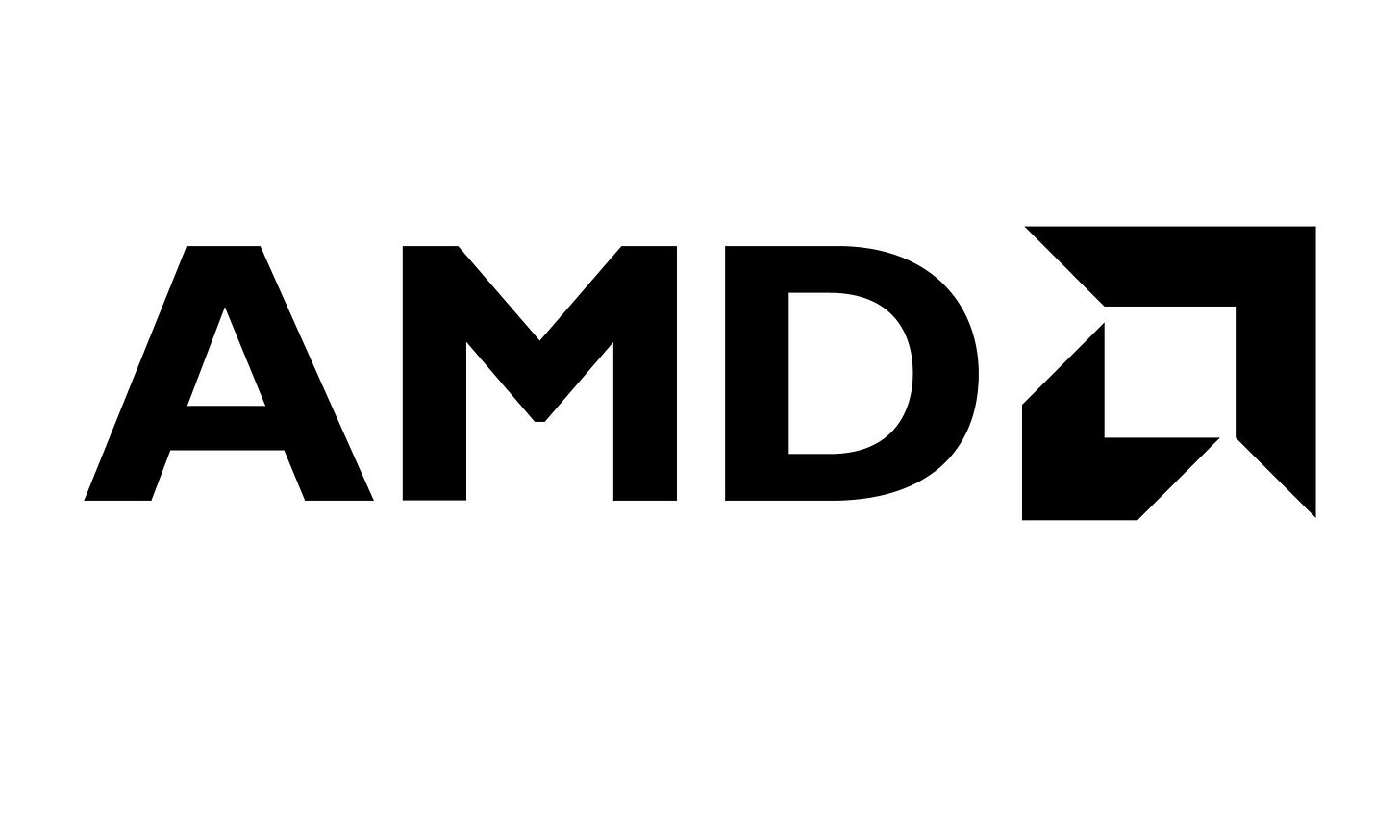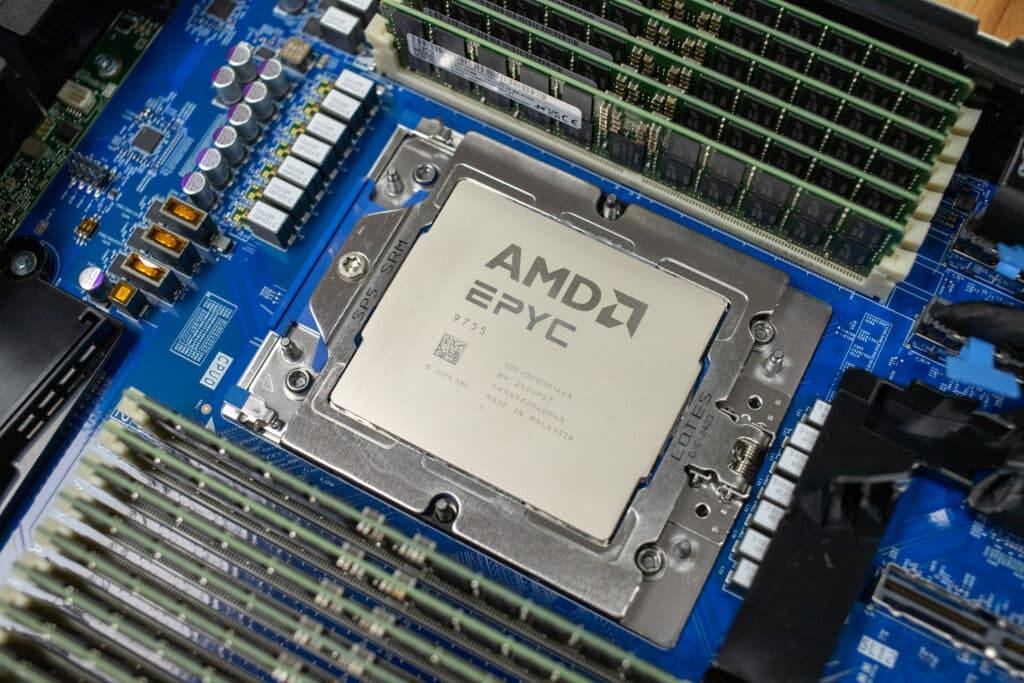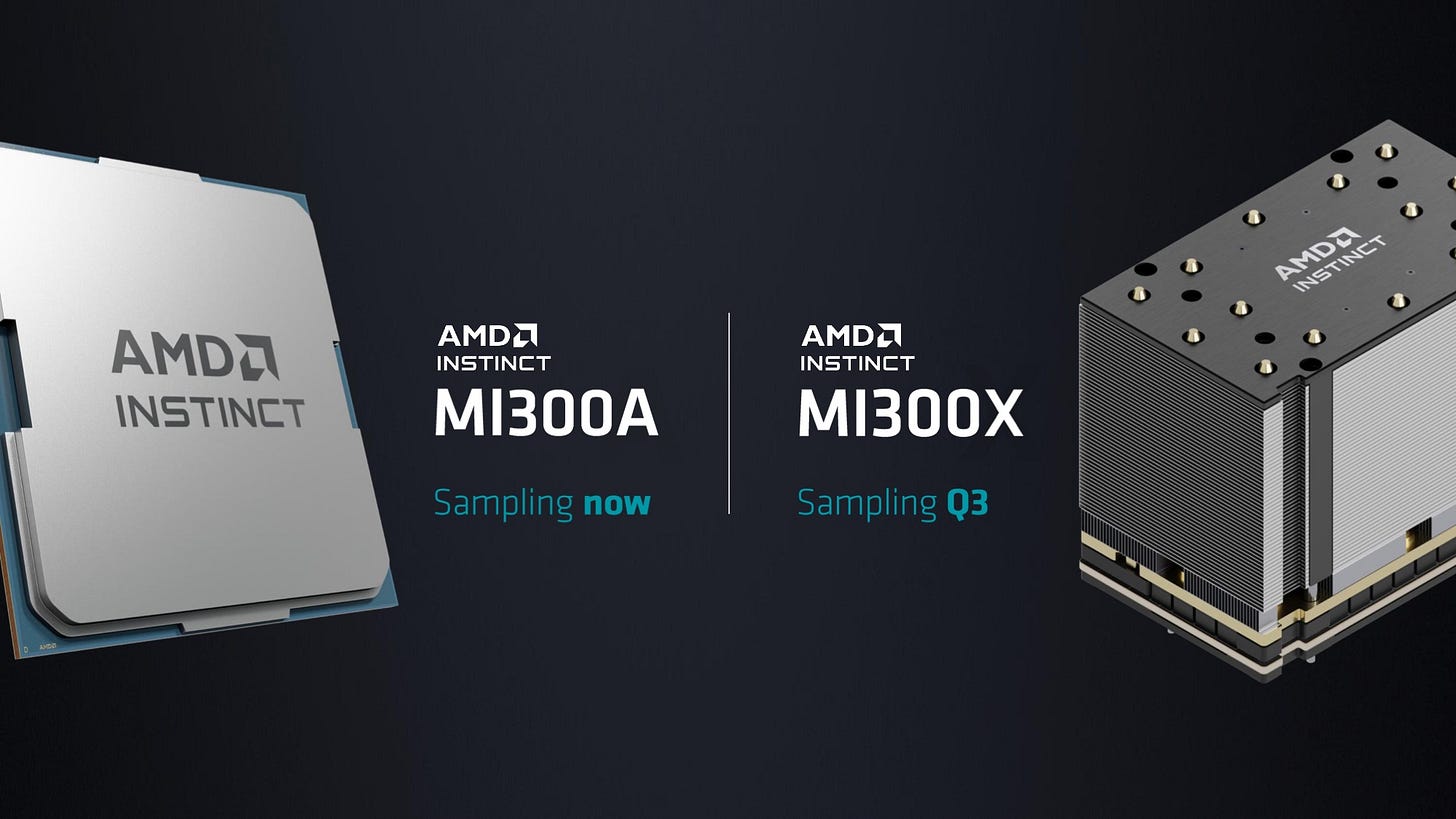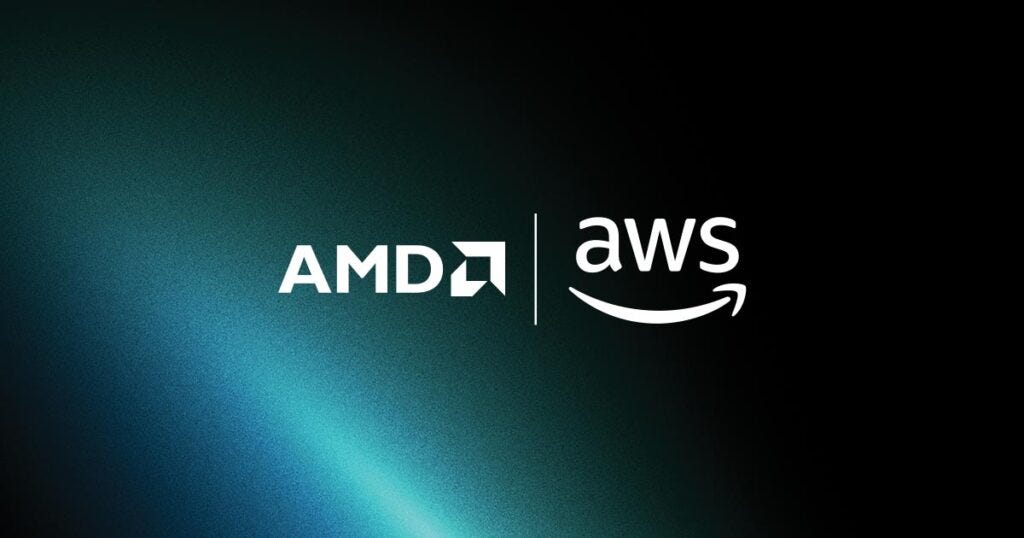AMDs 10x Potential: The Next Big AI & Cloud Computing Play
The Next Big AI and Cloud Computing Play!
If you think Advanced Micro Devices (AMD) is just an Intel alternative, you're missing the bigger picture.
AI is exploding. Cloud computing is reshaping entire industries. And AMD is positioning itself at the center of it all. And ready to dominate the next decade.
With cutting-edge chips, a surging Data Center business, and a growing Moat in high-performance computing, AMD isn’t just competing, it’s taking market share from giants.
The real question: Could AMD be a 10x opportunity in the making?
Let’s break down the key drivers behind AMD’s future growth and why this stock might be one of the biggest plays of the AI revolution.
Today, I’ll talk about the following:
Why AMD is one of the Best Options in the Semiconductor Space right now
Business Model
Moat
Products
Data Center Segment
AI Inference
AI Inference Race (AMD vs NVIDIA)
Partnerships
Final Thoughts
If you're interested in strong, and high-potential stocks, SUBSCRIBE to stay ahead of every market opportunity.
Why AMD is one of the Best Options in the Semiconductor Space right now
The AI boom is creating massive opportunities in the semiconductor space, but not all chipmakers are positioned to win. While NVIDIA has dominated headlines, AMD is quietly emerging as a serious contender with AI-driven growth, cutting-edge chips, and a valuation that looks far more reasonable than its biggest competitors.
With its MI300X AI accelerators gaining momentum, data center dominance expanding, and next-gen Zen 5 CPUs set to launch in Q2 (this is for the embedded segment, so we could see this segment earn more revenue in Q2 but I will talk about that further in the analysis), AMD isn’t just catching up, it’s gaining ground fast. And with >25% revenue growth in 2024, it’s proving that its AI strategy is more than just hype.
Is AMD the best semiconductor stock to own right now? Let’s break it down.
What’s making AMD money?
AMD’s revenue is driven by four major segments, each contributing to its position as a semiconductor powerhouse:
Data Center: powering the backbone of cloud infrastructure (50% of their revenue)
Client: providing advanced solutions for personal computing (28% of their revenue)
Gaming: delivering high-performance GPUs for next-gen gaming (10% of their revenue)
Embedded: offering specialized processors tailored for industries like automotive, healthcare, and consumer electronics (12% of their revenue)
With its diverse portfolio, AMD is set to dominate across key industries, positioning itself as a major player for years to come.
Now that you have a good understanding of the business and how AMD makes their money, let’s have a closer look at which segment has had the biggest yoy growth:
Data Center: grew by 94% in 2024, almost double from 2023
Client: grew by 52% in 2024
Gaming: declined by 58% in 2024
Embedded: declined by 33% in 2024
So, as you can see, we are seeing a strong increase in the Data center and Client segment. But, not so much in the Gaming and Embedded segment of the business.
In my opinion that seems plausible and understandable purely looking at it from a neutral perspective. The decline in the gaming segment can be attributed to a broader slowdown in the global gaming market, which has seen an overall downturn in recent years.
So, with that said, I don’t really, personally see much future in that segment as of today.
Where I do see, a bright future for AMD is in the Data Center market. In this segment I do feel like, they can profit of off the growth that this market will be going through in the next decade to come. Here is a good visual of the global data center market (in market cap) and where it could be evolving towards:
Keep in mind that these forecasts should be taken with a grain of salt. Later in my analysis, I will take a closer look at the Data Center market, highlighting the key opportunities for AMD. I will discuss this further in section five.
If you like reading about strong, and high-potential stocks make sure to subscribe so you don't miss any opportunities! Moat
AMD has built a strong moat around its business, meaning it has certain advantages that make it harder for other companies to catch up. But let’s look at the key parts of this moat:
1. Innovation in Processors
AMD is known for its innovation in CPU (central processing unit) and GPU (graphics processing unit) technologies. Over the years, AMD has developed cutting-edge chips that deliver excellent performance at competitive prices.
Zen Architecture: AMD’s Zen architecture is the backbone of its modern CPUs, including the Ryzen and EPYC chips. These chips offer high performance and energy efficiency, making them attractive for everything from personal computers to data centers. The innovation behind Zen has helped AMD close the performance gap with its main competitor, Intel, in CPUs.
RDNA and CDNA Architectures: For GPUs, AMD has developed RDNA and CDNA architectures, which allow their chips to compete with Nvidia's powerful graphics cards. These architectures have enabled AMD to provide better graphics performance at competitive prices, especially in gaming and data centers.
2. Price-to-Performance Advantage
AMD has built a reputation for offering more affordable products without sacrificing performance. This gives AMD an edge, especially in a market where price sensitivity is important.
Ryzen vs. Intel: In the CPU market, AMD’s Ryzen chips often offer better value for money compared to Intel’s offerings. Ryzen CPUs perform well in both gaming and productivity, and they tend to cost less than Intel’s chips that offer similar performance.
EPYC vs. Intel Xeon: In the server market, AMD’s EPYC processors offer excellent performance at a lower price point than Intel’s Xeon processors. This has made AMD a favored choice for cloud services, data centers, and enterprise applications.
3. Ecosystem and Partnerships
AMD has developed a strong ecosystem of partners, including companies like Microsoft, Sony, Dell, HP, and Google. These partnerships help AMD push its products into different markets, including:
Gaming Consoles: AMD powers both PlayStation and Xbox gaming consoles, giving it a huge presence in the gaming industry. The custom AMD chips in these consoles make them cost-effective and powerful for gaming, helping AMD gain significant market share.
Cloud Providers and Data Centers: AMD has partnered with major cloud providers like Amazon Web Services (AWS) and Microsoft Azure to use its EPYC processors in data centers. These partnerships give AMD access to the growing cloud computing market, which is a lucrative and expanding industry.
4. Advanced Manufacturing Technology
AMD uses advanced semiconductor manufacturing techniques, which are key to making their chips more efficient and cost-effective.
3rd Party Manufacturing (TSMC): AMD works with TSMC (Taiwan Semiconductor Manufacturing Company) to produce its chips. TSMC is one of the best in the world at making cutting-edge chips with smaller transistors that are faster and more energy-efficient. This helps AMD produce chips that rival its competitors in performance, while also allowing it to scale production.
7nm and 5nm Process: AMD’s chips are produced using the 7nm and 5nm processes, which refer to the size of the transistors. Smaller transistors mean more power-efficient and faster chips, which gives AMD an edge in both consumer and enterprise markets.
5. Strong Brand and Customer Loyalty
AMD has been able to build a loyal customer base due to its focus on delivering great value. Users, particularly gamers and tech enthusiasts, often see AMD as a reliable and affordable option for high-performance computing. This brand loyalty can help AMD maintain its market share, even in competitive markets.
Products
Now, let’s take a closer look at what AMD actually produces and the products they sell to their customers.
When analyzing a business, it's crucial to understand not just what they sell, but also why they sell it. That’s exactly what I’ll explain in this section.
Data Center
AMD EPYC (CPU)
The AMD EPYC Processor family delivers leadership performance for Enterprise, HPC, and AI workloads with advanced security features.
Examples:
9005
9004 & 8004
7003
7002
4004
Infinity Guard (security)
Enabling IT ecosystem security for a data-driven world
Energy efficiency
Processors power the most energy-efficient x86 servers in the game, delivering exceptional performance and helping lower energy consumption.
Leadership Performance
EPYC 9005 the best chip that AMD has built to accelerate data center, cloud, and AI workloads
Leading CPU for AI
AMD INSTINCT (GPU)
AMD Instinct is AMD’s high-performance GPU series for AI, machine learning, and HPC.
Designed for data centers and large-scale workloads.
Competes with NVIDIA’s AI-focused GPUs in AI training and scientific computing.
The Instinct MI300 series features advanced architectures for improved efficiency and power.
Optimized for AI acceleration, deep learning, and supercomputing applications.
Data Center Revenue
When talking about AMD’s future revenue streams. You can’t not talk about the Data Center revenue. At the moment the Data Center revenue accounts for around 12B dollars as of february 2025. (for around 50%)
How is this Industry Structured
Let’s have a look at the Data Center market and what it consists of:
Colocation Services: These facilities rent out space, power, and cooling to businesses, allowing them to house their servers without building their own data centers. A great example of a Colocation Data Center business is Equinax.
Cloud Service Providers: Companies like Amazon Web Services (AWS), Microsoft Azure, and Google Cloud offer scalable computing resources and storage over the internet, eliminating the need for businesses to maintain physical servers.
Data Center Infrastructure Vendors: These companies provide the hardware components such as servers, storage devices, and networking equipment that form the backbone of data centers.
Cloud Computing segment

Imagine you’ve a playstation 4 at home, but instead of buying a new, more powerful one every few years, you could ‘rent’ a super-powerful gaming system over the internet whenever you need it. This is kind of like cloud computing instead of buying and maintaining big, expensive computers, businesses can ‘rent"‘ computing power from companies like AWS or Google Cloud whenever they need it.
What are Virtual Machines (VMs)?
A Virtual Machine (VM) is like a pretend computer inside a real computer. Imagine you have a laptop, but inside that laptop, you can open a "window" that acts like a whole separate computer. In the cloud, businesses use these "pretend computers" (VMs) instead of buying actual hardware.
What is OPEX?
OPEX (Operating Expenses) is just a fancy way of saying "the money you have to spend regularly to keep things running."
If you own a car, your OPEX would be things like gas, insurance, and maintenance.
In cloud computing, OPEX means the monthly or yearly costs of using cloud services, like renting Virtual Machines.
What’s the Problem?
Many businesses moved their work to the cloud because it’s easier than managing their own computers. But the problem is that cloud costs can grow really fast, just like if you played an online game where you have to keep paying for upgrades.
How Does AMD Help?
AMD makes powerful computer chips that help these Virtual Machines run faster and more efficiently. If a business chooses AMD-powered VMs, they get:
✅ More power to run their apps
✅ Lower costs because AMD’s chips are designed to use energy more efficiently
✅ The ability to do more work without spending extra money
Imagine you and your friends are all renting bikes to ride around. Some bikes use a lot of energy to pedal, while others are super smooth and efficient. AMD is saying, "Hey, our bikes (computer chips) are the most efficient, so you can ride longer and faster without paying more for extra energy."
AI segment
AMD and AI: What’s the Connection?
For Everyday People (Retail)
Imagine your laptop or computer is like a brain. The smarter the brain, the better it can do things like understand speech, process videos, or even help you play games. AMD makes powerful computer chips that make these things faster, smarter, and more efficient.
Ryzen AI is a special kind of AMD chip that helps computers use artificial intelligence more efficiently.
These chips are used in laptops from brands like HP, Dell, and Lenovo, making them faster and better at things like video calls, gaming, and voice assistants.
A big improvement is longer battery life, so your laptop won’t die quickly while using AI-powered apps.
Example: If you’ve ever used a background blur effect in a video call or had your phone automatically edit a photo, that’s AI at work. AMD’s Ryzen AI chips make these tasks run smoothly and save power.
For Businesses (Companies & Data Centers)
Now, let’s talk about big companies and AI. Businesses like Microsoft, Meta, and Oracle need huge, powerful computers to handle things like:
Running AI models (like ChatGPT).
Storing and processing massive amounts of data (such as customer information or social media posts).
Running websites, apps, and online stores quickly and efficiently.
AMD makes special AI chips, like the MI300 Series, designed for these massive tasks. Think of these chips like supercomputers that work behind the scenes to make the internet, apps, and AI work better.
MI300A: A chip that processes AI tasks and big calculations super fast, used in scientific research and AI training.
MI300X: A chip that helps AI generate text, images, and videos, making AI responses faster.
Example: If a company like Netflix wants to recommend shows based on what you like, it uses AI to analyze your history. AMD’s chips help speed up that process.
Why This Matters
For everyday users, AMD’s AI chips make laptops and personal computers smarter and more efficient.
For businesses, AMD helps companies run powerful AI models and big cloud systems at a lower cost.
AI Inference
What is AI Inference?
Imagine you have a robot that learns to recognize pictures of cats and dogs. First, you show it lots of pictures, and it learns what makes a cat a cat and a dog a dog. This learning part is called training. After the robot learns, it can start recognizing new pictures it has never seen before. When it looks at a new picture, it uses what it learned to figure out if it’s a cat or a dog. This is called AI inference.
AI inference is basically when the robot or computer takes everything it’s learned and starts to make decisions or predictions with new, fresh information.
How AI Inference Works
For AI inference to work well, you need two important tools (processors):
CPU (Central Processing Unit):
Think of the CPU like the "brain" of the computer. It handles general tasks, like running programs and making sure everything is working. But it’s not super fast at doing many things at once.
GPU (Graphics Processing Unit):
The GPU is like the CPU’s helper. It’s amazing at doing lots of things at the same time. While the CPU does one thing at a time, the GPU can do thousands of things at once! This is super useful when you need to recognize patterns or make decisions quickly, like in AI.
In other words :
The CPU is used for tasks like control, data handling, and less complex inference.
The GPU is used for high-speed, parallel processing of complex models and is more efficient at handling AI inference for deep learning.
In many AI inference systems, both the CPU and GPU work together, with the CPU managing the workflow and providing control, while the GPU accelerates the heavy computational tasks needed for AI model predictions.
CPU + GPU
This chart illustrates that as AI workloads rise, GPUs become increasingly cost-effective. This confirms, what’ve just talked about.
What’s the Difference Between AMD and NVIDIA?
There are two big companies that make the processors that help with AI inference: AMD and NVIDIA. Both have their own chips, and they each have their pros and cons. So, let’s compare them both:
NVIDIA’s H100
Great at AI: NVIDIAs H100 chip is really powerful and is used by companies that need the best AI performance. It’s super fast at doing AI tasks.
Software: To make its chips work well, NVIDIA uses special software called CUDA. This software is really good at helping the chip do AI things, and a lot of AI models are made to work perfectly with CUDA.
Cost: Because the H100 is super powerful, it’s also really expensive. But it’s worth it if you need the top-level performance.
AMD’s MI300X
Good Performance: AMDs MI300X chip is also really good for AI, but it might not be quite as fast as the H100. However, it’s still super powerful and can do many AI tasks really well.
Recently, I discovered an article that showed that AMDs MI325X is able to show better performance than a H100 chip making it a better and cheaper alternative to NVIDIAs H100 chip.
Software: Instead of CUDA, AMD uses something called ROCm, which is open-source. This means anyone can use it and make changes to it if they want to. It’s great for people who want more flexibility and control over how their AI runs.
Cost: The MI300X is cheaper than the H100, so if you want to save money but still get good performance, this is a solid choice.
Key Differences
Performance: NVIDIA’s H100 is faster and more powerful than AMD’s MI300X, but the MI300X still does a great job for most AI tasks.
Software: NVIDIA uses CUDA (closed, meaning you can’t change it), while AMD uses ROCm (open, meaning you can change it if needed). If you want to do special things with your AI software, AMD is more flexible.
Cost: The H100 is expensive, while the MI300X is cheaper. If you don’t need the most powerful chip, AMD can save you money.
Conclusion
NVIDIA H100 is the best if you want super-fast performance and don’t mind spending a lot of money.
AMD MI300X is a cheaper option that’s still very good at AI tasks, and it lets you make more changes to the software if you want.
So, if you need the best performance and have the budget, go for NVIDIA H100. If you want something affordable and flexible, AMD MI300X is a great choice!
AMD vs NVIDIA (GPU Battle)
One thing I wanted to added to the previous section is the following article which compares the following: AMD Instinct MI300X vs NVIDIA H200 (with DeepSeek-R1 Inference)
AMD has made big improvements in AI performance by optimizing the DeepSeek-R1 model for its Instinct MI300X GPUs. By using advanced software tools and fine-tuning key settings, AMD has significantly boosted speed, reduced delays, and improved how well the system handles multiple tasks at once.
AMD Instinct MI300X: The AI Powerhouse Explained in Simple Terms
AI technology can feel complicated, but let’s break it down using everyday examples. Imagine you’re running a busy coffee shop. The speed and efficiency of your baristas (AI processors) determine how fast customers get their orders (AI tasks). AMDs MI300X GPU is like hiring a team of expert baristas who can make coffee faster, serve more customers at once, and work more efficiently than the competition.
Faster Service with Less Waiting
Think of throughput as the number of cups of coffee served per hour and latency as the time each customer waits. The MI300X serves 2 to 5 times more customers per hour than NVIDIAs H200 and reduces customer wait times by 60%, making it the ultimate high-speed barista for AI tasks.
Smarter and More Efficient Baristas
AMD has improved the “skills” of its AI processors (using the AITER library) to make them work smarter:
2x faster at basic coffee-making techniques (GEMM = simple calculations).
3x better at handling custom orders (MoE = complex decision-making).
17x quicker at preparing multiple drinks at once (MHA decode = processing AI requests).
14x faster at prepping ingredients before making the drinks (MHA prefill = setting up AI models).
This means the MI300X doesn’t just work harder, it works smarter and more efficiently.
Handling More Customers at Once
Imagine you run a coffee shop with 128 checkout lines, but your competitor only has 16. This means you can serve way more customers at the same time, and even during peak hours, you keep the waiting time under 50 milliseconds (the blink of an eye). That’s how AMDs MI300X processes AI requests compared to NVIDIAs H200, far more efficient and under heavy demand.
Conclusion
AMDs MI300X is like the ultimate coffee shop team. Faster, smarter, and capable of handling massive customer demand at once. For businesses and researchers working with AI, it means faster results, lower costs, and more productivity. A win-win in the world of artificial intelligence.
The AI Inference Race
The rise of artificial intelligence (AI) has intensified the competition between tech giants AMD and NVIDIA. As AI becomes more prevalent in industries like healthcare, finance, and autonomous driving, the demand for processing power to execute AI tasks, particularly machine learning, has surged. Let's explore how these companies stack up in terms of performance, cost-efficiency, and innovation.
AMD’s Advancements: EPYC (CPU) and MI300X (GPU)
AMD, traditionally known for its CPUs, has made a significant leap into AI inference with its EPYC processors and MI300X GPUs. The EPYC chips are designed for server-grade applications (software programs built to run on powerful computers called servers. These applications are designed to handle heavy workloads, run 24/7 without crashing, and support many users at the same time, like for example email servers), while the MI300X GPU is engineered to handle the complex computations required for AI tasks. Together, these two products offer a powerful combination for AI workloads, particularly for large-scale, parallel tasks like machine learning.
The Competition: NVIDIA’s CUDA Dominance
NVIDIA continues to lead the AI inference race, mainly due to its CUDA platform, which provides optimized AI software development tools. CUDA has become the industry standard, enabling developers to efficiently write, compile, and execute machine learning code on NVIDIA hardware. This gives NVIDIA a significant edge when it comes to tailored, performance-optimized AI applications. However, NVIDIA's closed ecosystem can sometimes restrict developers who prefer open-source flexibility.
Open-Source Flexibility with AMD's ROCm
AMD’s strategy, on the other hand, leans heavily on ROCm (Radeon Open Compute), an open-source platform that provides flexibility for developers. While it may not yet have the same widespread adoption as CUDA, ROCm’s open-source nature allows for greater customization of AI models and software. This flexibility appeals to developers who want to avoid the restrictions of proprietary software. In addition, AMD's cost-efficient solutions make it an attractive alternative for companies looking to optimize their AI operations without breaking the bank.
AI Benchmarking: AMD’s Progress
Recent MLPerf benchmark results show AMD's growing competitiveness in AI. While NVIDIA remains dominant in certain categories, AMD’s MI300X has demonstrated notable performance gains, particularly in areas requiring parallel processing. This positions AMD as a strong contender, especially for applications where multiple GPUs are needed to handle large AI workloads.
The Bottom Line: Cost-Efficiency vs. Optimization
When comparing AMD and NVIDIA, the choice largely depends on the specific needs of a business or developer. If top-tier performance and software optimization are the priority, NVIDIA remains the best choice. However, if a company values flexibility, cost-efficiency, and scalability, AMD offers a compelling alternative. Both companies are pushing the boundaries of AI innovation, but AMD’s aggressive pricing strategy and growing performance make it a strong challenger to NVIDIA’s dominance in the AI inference race.
Partnerships
Amazon Web Services (AWS)
AWS collaborates with both NVIDIA and AMD to provide customers with a range of computing solutions tailored to diverse workloads. Here's an overview of each partnership:
NVIDIA and AWS Collaboration
AWS and NVIDIA have maintained a longstanding partnership, focusing on delivering high-performance computing solutions for various applications, including machine learning, high-performance computing, and graphics-intensive workloads. Key aspects of this collaboration include:
GPU-Powered Instances: AWS offers Amazon EC2 instances powered by NVIDIA GPUs, such as the A100 Tensor Core GPUs, designed to accelerate machine learning training and inference tasks.
Generative AI Initiatives: In December 2024, AWS and NVIDIA announced Project Ceiba, aiming to build one of the world's fastest AI supercomputers. This collaboration leverages NVIDIAs advanced GPUs to enhance generative AI capabilities on AWS.
Quantum Computing Integration: AWS and NVIDIA have integrated the CUDA-Q quantum development platform into Amazon Braket, facilitating hybrid quantum-classical computing workflows for researchers.
AMD and AWS Collaboration
AMD and AWS have partnered to offer cost-effective and high-performance computing solutions, particularly for general-purpose and memory-intensive workloads. Key elements of this collaboration include:
AMD EPYC Processors: AWS provides Amazon EC2 instances powered by AMD EPYC processors, delivering scalable performance for a variety of workloads, including databases, enterprise applications, and big data analytics.
Cost Efficiency: Instances powered by AMD EPYC processors are designed to offer a balance of performance and cost, making them suitable for businesses seeking to optimize their cloud computing expenses.
AWS ISV Accelerate Program: AMD has joined the AWS Independent Software Vendor (ISV) Accelerate Program, aiming to enhance its collaboration with AWS and provide integrated solutions to customers.
Key Differences in Collaborations
Performance and Specialization: NVIDIA's collaboration with AWS emphasizes high-performance GPUs tailored for AI, machine learning, and HPC workloads, leveraging NVIDIA's specialized hardware and software ecosystems. In contrast, AMD's partnership focuses on providing cost-effective, general-purpose computing solutions suitable for a wide range of applications.
Software Ecosystem: NVIDIA's CUDA platform offers a mature and widely adopted environment for developers, particularly in AI and machine learning domains. AMD's ROCm platform, while open-source and flexible, is still evolving and may not yet match the extensive support and optimization found in CUDA. (user friendly?)
Strategic Initiatives: NVIDIA and AWS's joint ventures, such as Project Ceiba, aim to advance generative AI capabilities, highlighting a focus on cutting-edge AI research and applications. AMD's collaboration with AWS, including participation in the ISV Accelerate Program, underscores a commitment to enhancing cloud computing performance and cost efficiency across various industries.
In summary, while both NVIDIA and AMD collaborate with AWS to provide computing solutions, their partnerships differ in focus, performance optimization, and strategic objectives, catering to diverse customer needs in the cloud computing landscape.
Final Thoughts
If you still think of AMD as just an alternative to Intel, it’s time to rethink that perspective. The company has evolved far beyond its traditional role in personal computing, positioning itself at the forefront of AI, cloud computing, and high-performance data centers.
The numbers tell a clear story: AMD’s Data Center business is exploding, with 94% YoY growth in 2024. While gaming and embedded segments have seen declines, the overall trajectory is clear. AMD is doubling down on AI and cloud, the two sectors shaping the future of technology.
Its “strong competitive” moat, driven by cutting-edge processor innovation, cost efficiency, strategic partnerships, and a growing presence in AI Inference, sets it apart from the competition. While NVIDIA remains the dominant force in AI GPUs, AMD is rapidly gaining ground with its MI300X, leveraging open-source flexibility and aggressive pricing to challenge the market leader.
Looking ahead, the next decade could be transformative for AMD. As demand for AI-driven workloads and data center computing surges, AMDs ability to deliver high-performance, energy-efficient chips at a competitive price point makes it a formidable player in the semiconductor industry.
The real question isn’t whether AMD can compete, it’s how far it can go.
Could this be a 10x opportunity in the making? The signs are pointing in that direction.
If you're looking for high-potential stocks with strong growth drivers, AMD should be on your radar.
Thank you for reading all the way to the end! I really appreciate you taking the time to check out my articles. If you enjoyed it, don’t forget to SUBSCRIBE so you won’t miss any future posts!
If you think I missed something important, feel free to leave a comment!
Disclaimer:
The content of this analysis is for informational purposes only and should not be considered financial or investment advice. The opinions expressed are my own and based on publicly available information at the time of writing. Before making any investment decisions, please conduct your own research or consult with a professional financial advisor to assess your individual situation. Investing in the stock market involves risk, and past performance is not indicative of future results.
















Fantastic deep dive, thanks.
Great stuff! Very well put together and obviously some great research and insights into AMD in this one. I used to be an investor in AMD but pulled out a while ago, might look into investing again especially with the influx of data centers pushing up